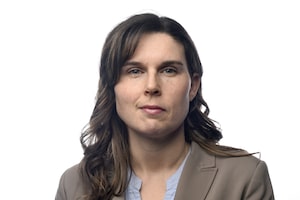Team Nunavut badminton player Davidee Kudluarok, 13, leaps high as he competes in under-16 males single badminton competition during the 2017 North American Indigenous Games in Toronto on Friday. Davidee won bronze in singles and later won silver in boys doubles with his cousin, Mike Kavik.Mark Blinch/The Globe and Mail
The first medals for Nunavut at Toronto's North American Indigenous Games came in a flurry on Friday, earned by a team of talented teenagers from the Arctic in a most unlikely sport – badminton.
Nunavut athletes captured four badminton medals at Toronto's Pan Am Sports Centre on the final day of a five-day tournament that featured Indigenous athletes from 15 provinces, territories and states. Not bad for a collection of kids who attend just one or two tournaments a year because of the enormous travel challenges in their rugged territory.
Davidee Kudluarok, a 13-year-old competing in the under-16 category, earned bronze in boys singles, then won a silver in boys doubles with his cousin, Mike Kavik. The two cousins also squared off in an all-Nunavut bronze-medal mixed-doubles match, with Kavik and Carla Kaayak beating Kudluarok and Lucy Jo Appaqaq in the kind of intense three-setter the two pairs routinely play in training. The team of Anna Lambe and Mina Mannuk added a bronze medal in the U19 girls doubles.
The eight athletes on Nuvavut's NAIG badminton team flew here from all over the territory – from Baker Lake in its centre, to the capital of Iqaluit in its far east – and one player from Grise Fiord, Canada's most northern inhabited community. Five are native to Sanikiluaq, a community of some 800 people on the Belcher Islands, 100 kilometres west of Northern Quebec on Hudson's Bay. They train at Paatsaali High School, where most of the students are Inuit and speak Inuktitut, and there's a keen interest in the local badminton program.
"It's not an expensive sport, since you don't need much equipment, so in a small community, badminton is a perfect sport," said the team's coach, Stephen Keoughan, a New Brunswicker who has worked 17 years in Nunavut, is an elementary school principal and runs a thriving badminton program in Sanikiluaq. "You don't need two full teams of players like in many team sports. You can play with just a few kids."
Keoughan runs a program there in the high school gym with Sanikiluaq athletes of various ages and abilities, some as young as fifth grade. They seek out lots of Canadian badminton experts to come run clinics there. Keoughan estimates the NAIG athletes based there trained for some 250 hours this year.
"I got a silver medal in NAIG 2014 in Regina, and I wanted to win more medals again and I'm very happy for these other players," said Mannuk, a 19-year-old from Sanikiluaq, the team's only returning player. "This one is bigger and more challenging, more competitive."
Some of the kids on Nunavut's NAIG badminton team faced long and winding journeys to Toronto at more than $2,000 a flight. Take 17-year-old Nolan Kiguktak, who needed a four-day trip to get from Grise Fiord to Toronto. Canada's northernmost civilian settlement has just 130 people and is one of the world's coldest inhabited places. There are no connecting roads and the only way out is via a tiny airstrip, which has a very difficult approach. Flights leave there just two days each week.
"I flew from Grise Fiord to Resolute, then to Arctic Bay, then to Pond Inlet, then to Iqaluit where I stayed with a teammate's family for two days and we all flew to Ottawa from there, then to Toronto," said Kiguktak, who added he hopes to become a pilot someday. "I usually play the same two kids in my community to train. This trip has been amazing. I've learned so much about badminton."
Two years in a row, Kiguktak couldn't make it to Nunavut's territorial badminton championships because he was snowed into his community. But he was among an elite group of players from across the territory flown in on a special charter plane for a selection camp in Sanikiluaq this winter.
A team of eight was chosen and they went to Toronto for NAIG one week early for an intense training camp at University of Ontario Institute of Technology in Oshawa. The team also bonded with a trip to Canada's Wonderland, where many of the kids had their first rides on a roller coaster. They did things many of them can't do back home – see movies in a theatre, go shopping and buy pop at reasonable prices. Some have travelled routinely to other parts of Canada, while others rarely leave the North.
The Nunavut players, all decked in matching yellow jerseys, black shorts and lime-green court shoes, huddled to cheer and support one another during a long day of finals in which Nunavut players were constantly on the court. Kavik and Kudluarok had a cousin from Kitchener in the stands watching and broadcasting the game to family back in Nunavut over her phone using Facebook Live.
"Me and my cousin wanted to win gold," said a very shy Kavik. "But we are also happy, because we trained a lot."
 Rachel Brady
Rachel Brady